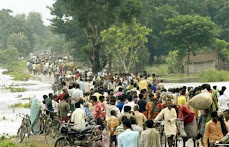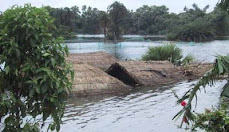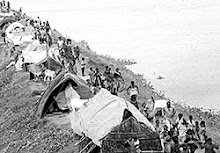by Dinesh Kumar Mishra
The foundation stone of the Kosi Project was laid on January 14, 1955 amidst fanfare, jubilation and victory. Dr. Shrikrishna Sinha, thgen Chief Minister of Bihar, laid the foundation stone near Bhutaha village close to Nirmali, in Saharsa (now Supaul) district with the chanting of mantras by Pt. Mahabir Jha of Jhitki village and shouting of slogans like 'Aadhi Roti Khayengein, Kosi Bandh Banaayengein.' (We will eat only half a chapati but we will surely build the Kosi embankments). A majority of people lost the other half of the bread too on the 18th August 2008 when the Kosi embankment breached on that day.
Col. Townsend of the US Army while deliberating in a seminar organized by the American Society of Civil Engineers to discuss the Mississippi floods of 1927 had said that even the best designed and carefully constructed embankments remain at the mercy of burrowing animals like rats, foxes, muskrats who can create a hole in the finest levee that has been devised, which if not closed within a few moments will ensure its destruction. The Mississippi River of the United States broke loose in 1927 inundating an area of 51,200 sq. kilometer and damaging property to an estimated extent of two hundred million to a billion dollars. The breaches drove nearly three quarters of a million people from their homes and six hundred thousand of them were dependant on Red Cross. The wealth and power of the United States enabled much to be done for the sufferers, still they suffered. He further added a 'careless supervisor and dark nights' to the list destroyers of embankments. His observations remain valid till date as the Kosi comes out of its shackles in Kusaha in Nepal some 13 kilometers upstream of the Kosi Barrage. All the eight breaches that have occurred so far can be brought under these categories.
Col. Townsend gave benefit of doubt to the planners and engineers when he prefixed 'best designed and carefully constructed' adjectives to the embankments. The Kosi has breached its embankment eighth time and it is for the first time that the 'disaster' has generated so much of interest. These embankments are spaced at an average distance of 9 to 10 kilometers below the barrage with a maximum width of 16 kilometres between Kisunipatti and Bhaptiahi and minimum width of nearly 3 kilometres at the barrage itself. The spacing of the embankments is only 8 kilometres at the tail end, between Baluaha Ghat and Ghonghepur. In Nepal portion the spacing between them is restricted to between 3 to 6 kilometers. Common sense suggests that the spacing between the embankments should increase as the river advances further as more and more streams join the river from western side. This simple common sense was kicked around when these embankments were constructed in late 1950s. There were 304 villages with a population of 192,000 (1951 census) going to be trapped between the embankments and each one of them was trying to be located outside the embankments. Later the embankments were extended and 380 villages of Bihar and 34 villages of Nepal came within them. Their current population is nearly 1.2 million. The village locations were fixed and it was the embankment on either side of the river that could be moved. So did it happen. Now the embankment alignment is a caricature of what it was designed, if there was any design.
Chinese Deputy Prime Minister Teng Tse Hui discussing the floods in the Hwang Ho had once said in 1955 that according to historical records, there have been inundations and breaches on 1500 or more occasions on the lower reaches of the river and there were 26 important changes of course, nine of them major…..The terrible floods of 1933 caused more than 50 breaches of the dykes and brought disaster to more than 11,000sq. km. Over 3,640,000 people were affected and over 18,000 killed. Property worth some 230 million Yuans was lost. In 1938, Chiang Kai Shek Government opened the dykes on the south bank of the river at Huayuan Kou near Cheng Chow in Honan province. This led to a major change in the course of the river affecting 54,000 sq. km. with a population of 12,500,000 and 890,000 people died….In a hundred years, from 1855 till 1955, the dykes had breached on 200 occasions. According to an on the spot survey in the river bed in lower reaches was found to be rising by one to ten centimeters every year in the middle of this century. In some cases the existing river bank was found even ten meters higher than the surrounding country level. Such rapid silting cannot be dealt with simply by piling up and reinforcing dykes. In a sense, higher and stronger the dykes, the quicker is the silt deposited because it has no way of getting out. The Kosi embankments were constructed citing the wonderful performance of these two rivers.
Had Col. Townsend been living today, he must have amended his statement saying that the embankments could be ill-conceived, ill-designed and poorly constructed too. Capt. G.F. Hall, former Chief Engineer of Bihar was of the opinion that the embankments can only postpone the day of retribution and will be a store of disaster for the future generation. A status paper prepared by Government of Bihar in 2003 suggests that those who subscribe to such views are the people of colonial mindset.
The 'nationalist' embankment builders had a last laugh when they succeeded in bringing Dr. Rajendra Prasad, then President of India' to Bihar between 17th to 22nd October 1954 and made him request the people to participate in the 'yagna' of nation building by constructing the Kosi embankments. His views in the Patna Flood Conference (1937) were diagonally opposite to what he was made to say in 1954. One can imagine the stress the President might have undergone during that trip of his home state of Bihar.
Embankments prevent a river from overflowing its banks during floods but they also prevent the entry of floodwater. This leads to a major problem as the embanked river is no longer able to fulfill its primary function – draining out excess water. With the tributaries prevented from discharging into the river and accumulated rainwater finding no way out, the surrounding areas quickly become flooded. The situation is aggravated by seepage from under the embankments. The areas outside the levees remain waterlogged for months after the rainy season because this water has no way of flowing out to the sea. Theoretically, sluice gates located at these junctions should solve the problem but, in practice, such gates quickly become useless; as the bed level of the main river rises above the surrounding land, operating the gates lets water out instead of allowing outside water in. When the sluice gates have failed, the only option left is to also embank the tributary. This results, then, in water being locked up between the embankments. Moreover, no embankment has yet been built or can be built in future that will not breach. When a breach occurs, there is a deluge. This is what happened at Kusaha this year on the 18th August 2008.
Proponents of embankments have tried to rationalize the jacketing of rivers thus: Forcing the same quantity of water through a narrow area, as happens in case of an embanked river, increase the water velocity thereby increasing its eroding capacity. The increased velocity of water dredges the river bottom and transports the sediment out preventing the rise of riverbed levels, increasing the carrying capacity of the river and reducing the extent of flooding. These were the arguments put forward by engineers in independent India when they resorted to massive embanking of rivers in the Ganga and the Brahmaputra basin. Unfortunately, there has been little evidence to date that this theory is actually being substantiated anywhere on Indian rivers. The technical debate, however, continues at that level.
At the field level in the flooded areas of Bihar, there is a continuing debate on polythene sheets, rice, vegetables, salt, candle and match-boxes etc. How strategic is this deflection of debate that the people discuss keep discussing about sattu (ground gram), chura (flattened rice) candles and matchboxes. This is what precisely the politicians want and if they are not brought to the real issues of dealing with the sediments, floodwaters, accountability and an informed debate; the event would simply pass of as the earlier ones.
Historically, floods and their control have never been a big issue in the Ganga-Brahmaputra basin, as it is today. Floods became a major issue after the British occupied India. When they examined the Ganga basin, they believed that if it could be made “flood-free”, they could levy a tax in return for such protection.
Tuesday, 23 September 2008
Subscribe to:
Post Comments (Atom)








No comments:
Post a Comment